Subodh never runs away

I open Facebook on my phone. I then tap on "What's on your mind?" and type a post lambasting—ahem—those you cannot lambast. No, I do not post the status. Instead, I keep my finger pressed on the backspace button and erase every word I typed. This is hardly new for a rabid social media user like me. Self-censorship had always made me feel that we have reached our lowest ebb. But a recent news report was such that I was at a loss for words.
It said that a coterie of operatives has hit the road to find out the artiste(s) who painted a series of graffiti depicting 'Subodh'—or conscience—in the form of an ill-fated man on Dhaka's walls.
Certain quarters are wary of something fishy, the report goes on, and they believe it to be the work of an anarchist element, which, if not controlled, could induce fear in people's mind. How and why they have made such an assessment is hardly understandable. When I first came across 'Subodh', fear was the last thing that came to mind.
It deeply resonates with us, the youth, for reasons inexplicable. With a cage confining the sun under his right arm, the man is urged to run away and not come back ever, for time is not in his favour, for humans have forgotten how to love, for his luck has run out.
In one of the artworks, Subodh finds himself behind bars, with an aside that reads "sinfulness is entrenched in human minds." The sun in the cage, at times, looks golden yellowish, heralding the dawn. Other times, it is red, as if summoning the dusk.
Many compare this exquisite street art with that of Banksy, the anonymous England-based graffiti artist. I'm perhaps not the best person to review artwork, but Banksy's is more straightforward and carries a specific political message. Subodh, on the other hand, is familiar yet enigmatic.
We all agree that the artwork contains meaning, but the interpretation varies from person to person. Some say it depicts the minorities who are finding it increasingly harder to live in their ancestral land. Some believe Subodh is the face of the dissenting voice or free speech under siege. To me, Subodh represents our collective conscience.
That said, 'HOBEKI?'—which translates to "Will it happen?" in English—the signature that sometimes accompanies Subodh, is genuinely ambiguous. What will happen? It's a question puzzling enough to bother the inquisitors, too.
The last two graffiti works are more intriguing. Unlike all the previous works that featured a despondent and hopeless Subodh, the new ones appear to evoke hope or aspiration. With him now is a little girl who asks him, "Subodh, when will dawn arrive?" The next graffiti depicts the sun about to exit the cage, with a rooster crowing desperately—a sign that dawn may finally be here.
It appears the entire thing has been interpreted by some a whole lot differently, and a bit too seriously. A security analyst was quoted by the newspaper in its report as saying, "It was drawn to instil fear among the public. This is propaganda—a strategy to elicit fright." He senses subversion. Another noted political commentator admits that it is "difficult" to decipher the graffiti, but he offers a historical event, in which four pieces of ruti—or bread— carried a particular symbolic significance.
The matter, as it stands now, has come to this: Whoever is masquerading as a graffiti artist, "plotting" some kind of subversive activity, must be detained. The absurdity of it reminds a friend of mine of a book, Matigari, written by famous Kenyan writer Ngugi wa Thiong'o. Matigari, named after its central character, is the story of a freedom fighter who seeks to find his family and rebuild his home in his newly liberated country. However, he soon realises that the state he helped become independent is still ruled by the corrupt. Then rumour springs up of a superhuman in quest of true liberation, stoking rebellion to take up arms against the regime of the day.
The novel, although a fictional account, alarmed the-then Kenyan despot, President Daniel arap Moi, to such an extent that he issued an arrest warrant against Matigari, a fictional character. Unable to arrest someone who only exists in the pages of a novel, the dictator, in the words of Jeff Turrentine, "had to settle for the next best thing: seizing all copies of the novel that bore his name and—to use a normally intransitive verb that has found its transitive form in the vocabulary of despots—'disappearing' them."
What is common between Subodh and Matigari is their mysterious identity. Subodh invokes the same questions as Matigari's.
"Who is Matigari? They asked one another. How on earth are we going to recognise him? What does he look like? What nationality is he? Is Matigari a man or woman anyway? Is he young or old? Is he fat or thin? Is he real or just a figment of people's imagination? Who or what really is Matigari ma Nijiruungi? Is he a person, or is it a spirit?"
To me, Subodh is a spirit—something that never runs away.
Nazmul Ahasan is a member of the editorial team at The Daily Star.






Comments